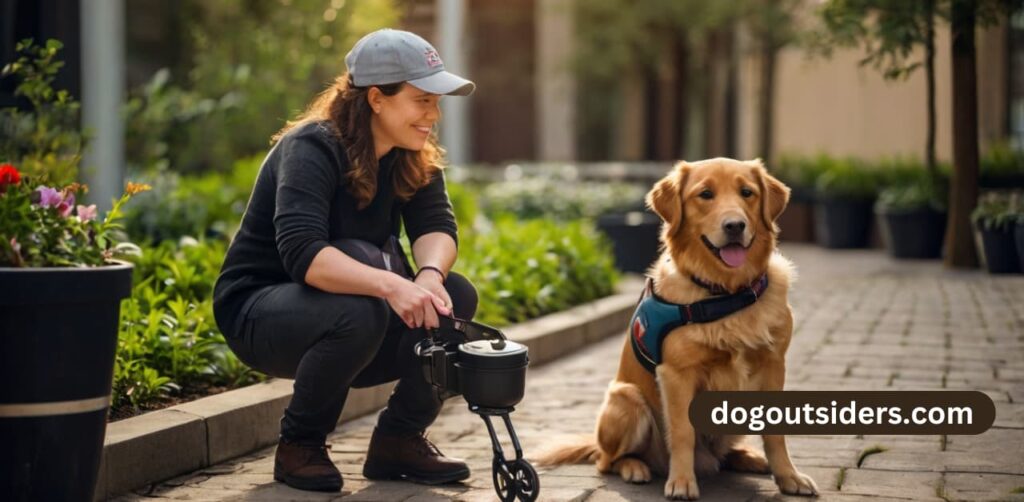Can you get a service dog for POTS? Many individuals with Postural Orthostatic Tachycardia Syndrome, or POTS, may wonder if a service dog could be beneficial in managing their symptoms and improving their quality of life. Service dogs can be trained to assist individuals with various medical conditions, including POTS. These specially trained dogs can provide support by alerting their handlers to changes in heart rate or blood pressure, fetching medications or water, providing stability during episodes of dizziness or fainting, and offering emotional support during difficult times. Let’s explore how service dogs can help individuals with POTS lead more independent and fulfilling lives.
Key Takeaways
- If you have Postural Orthostatic Tachycardia Syndrome (POTS), consider how a service dog can help you manage daily challenges, as they are trained to assist with specific tasks.
- Service dogs can perform crucial tasks for those with POTS, such as providing stability during sudden dizziness or alerting to medical emergencies.
- Beyond physical support, service dogs can significantly improve mental health by offering companionship and reducing anxiety related to POTS symptoms.
- Familiarize yourself with the legal requirements for obtaining a service dog to ensure you understand your rights and the necessary documentation.
- To qualify for a service dog, follow the outlined steps, including obtaining a medical recommendation and demonstrating a need for assistance in daily activities.
- Be prepared for the costs involved in acquiring a service dog, which may include training, supplies, and ongoing care.
Understanding Postural Orthostatic Tachycardia Syndrome

Definition of POTS
Postural Orthostatic Tachycardia Syndrome (POTS) is a condition that affects blood flow regulation and may benefit from cardiac service dogs, emotional support dogs, or assistance dogs. It leads to an abnormal increase in heart rate when a person stands up, which can be monitored by assistance dogs like cardiac service dogs.
This condition can cause various symptoms that impact daily life, including the need for assistance dog or cardiac service dogs.
I have seen how difficult it can be for someone with POTS, especially with the help of an assistance dog or cardiac service dogs. The body struggles to maintain blood flow, leading to discomfort and fatigue, even with assistance dog or cardiac service dogs. It’s not just about feeling tired; it’s about managing everyday tasks with the help of cardiac service dogs and assistance dogs while dealing with heart rate changes.
Common Symptoms
Common symptoms of POTS include palpitations, lightheadedness, fainting spells, and the need for cardiac service dogs. People often experience an increased heart rate upon standing. Some may also have oncoming fainting episodes, which can be frightening for those with assistance dogs or cardiac service dogs.
I remember my friend describing her experiences with random fainting spells and how her assistance dog and cardiac service dogs helped her. She often felt dizzy and weak, especially after sitting for long periods, prompting her to consider an assistance dog or cardiac service dogs.
Other symptoms can include fatigue, nausea, and difficulty concentrating. These symptoms vary from person to person but significantly affect quality of life, often necessitating assistance dogs or cardiac service dogs. Many people find it hard to engage in physical activities due to the risk of experienced fainting, even with assistance dogs like cardiac service dogs.
Prevalence of POTS
POTS is more common than many realize, affecting approximately 6 million Americans. This number shows how widespread this condition is within the population. Despite its prevalence, many people remain unaware of POTS, its implications, and the role of assistance dogs or cardiac service dogs.
The lack of awareness about assistance dogs and cardiac service dogs can lead to misunderstandings about the condition. Friends and family may not recognize the struggles faced by those living with POTS, including the need for a cardiac service dog. I think it’s essential for everyone to understand that POTS is a legitimate medical condition, especially for those who may need a cardiac service dog. It requires proper diagnosis and management.
Impact on Daily Life
Living with POTS can be challenging. Simple tasks like standing up or walking with a cardiac service dog can become daunting. The fear of fainting can lead to anxiety and social withdrawal, prompting some to seek a cardiac service dog. Many individuals must adapt their lifestyles, including the use of a cardiac service dog, to manage their symptoms effectively.
To manage blood flow, individuals may turn to methods like wearing compression garments or increasing their salt intake, especially if they have a cardiac service dog. Some people might also depend on medications that their doctors prescribe. The effectiveness of these strategies can differ from person to person. It’s essential for anyone facing these symptoms, particularly those with a cardiac service dog, to seek advice from a healthcare professional for tailored solutions.
How POTS Impacts Daily Life

Physical Limitations
POTS can severely limit physical activities for many individuals. Simple tasks like walking or standing can become exhausting. A person may feel lightheaded or fatigued after just a few minutes of standing with a cardiac service dog. I know from experience that even short walks with my cardiac service dog can leave me breathless. The heart races to maintain blood flow, leading to exhaustion, much like a cardiac service dog.
Living with POTS can lead to challenges in social interactions. People may hesitate to accept invitations from friends due to the worry of experiencing symptoms, particularly when accompanied by a cardiac service dog. This fear often results in missed gatherings because of fatigue or dizziness, contributing to feelings of loneliness and isolation.
Daily Challenges
Daily tasks can turn into significant challenges for POTS patients with a cardiac service dog. Brushing teeth or taking a shower with a cardiac service dog might require sitting down afterward. These activities can drain energy quickly. Many find it difficult to maintain a routine because symptoms vary daily, even with a cardiac service dog.
Brain fog is another common issue faced by people with POTS, often alleviated by a cardiac service dog. This cognitive impairment makes it hard to concentrate or remember things. I often struggle to focus on conversations, which can be frustrating and embarrassing.
Emotional Toll
Living with a chronic condition like POTS takes an emotional toll. Anxiety and depression are common among sufferers. Uncertainty about when symptoms will strike creates stress. Many worry about their ability to function day-to-day.
Support systems are crucial for managing these feelings. Friends and family can help by understanding the condition better. Open conversations about needs and limitations can ease some anxiety.
The emotional impact is significant, as well. I’ve felt overwhelmed at times, fearing that my condition defines me. It’s essential to acknowledge these feelings and seek help when needed.
Role of Service Dogs in Managing POTS

Support for Individuals
Service dogs play a vital role in supporting individuals with POTS. These specially trained animals can help manage symptoms and enhance daily life. They offer emotional support and physical assistance. For those with POTS, everyday tasks can be challenging. A service dog can help reduce anxiety and provide companionship.
I have seen how a service dog can change someone’s life. The bond between a handler and their dog is strong. This relationship often leads to increased confidence and motivation.
Enhancing Safety and Independence
Service dogs enhance safety for their handlers. They can alert to changes in heart rate or blood pressure. This timely warning can prevent falls or fainting episodes. They can assist with mobility by providing balance support.
Independence is another key benefit of having a service dog. Handlers often feel more secure when out in public. With a service dog by their side, they may navigate crowded places more easily. This independence can lead to improved mental health and well-being.
Growing Demand for Training
The demand for service dogs trained specifically for POTS is increasing. More people recognize the benefits these dogs provide. Organizations are now focusing on training dogs for this purpose. They teach dogs to recognize symptoms and respond accordingly.
Training requires time and effort. Many organizations partner with medical professionals to ensure proper training techniques. As awareness grows, more resources become available for those seeking assistance.
I believe that the growing interest in service dogs reflects society’s understanding of invisible illnesses like POTS. People need support and companionship, especially when dealing with chronic conditions.
Tasks Service Dogs Perform for POTS
Balance Assistance
Service dogs can provide balance assistance for individuals with POTS. They help clients maintain stability while walking. This support reduces the risk of falls, which can be a significant concern for those with this condition.
I often find myself feeling lightheaded when I stand up too quickly. Having a service dog by my side would make a big difference. Their presence could help me feel more secure during daily activities.
Retrieving Items
Dogs can also retrieve items for their handlers. If someone drops medication or needs a water bottle, the service dog can fetch it. This task is crucial during moments of dizziness or fatigue.
My friend has a service dog that helps her pick up things she cannot reach. This assistance allows her to maintain independence and manage her symptoms better.
Alert Tasks
Another important role is performing alert tasks. Service dogs can sense changes in their handler’s body. They might alert their owner before fainting episodes occur. This early warning allows the person to sit or lie down safely.
Certain dogs undergo specialized training to detect unique scents that indicate fluctuations in blood pressure or heart rate. This skill can prove crucial during emergencies.
Medication Reminders
Service dogs also assist with medication reminders. They can be trained to nudge their handler at specific times to take medications. This task ensures that individuals stay on track with their health routines.
Many people struggle with remembering when to take their meds. A service dog can help bridge that gap and promote better health management.
Customization of Tasks
The tasks performed by service dogs should be customized based on individual needs. Each person’s experience with POTS varies greatly. Therefore, it’s essential to work closely with healthcare providers when determining which tasks will be most beneficial.
Training organizations play a vital role in this process. They assess the specific needs of each client and train the dogs accordingly. Trainers focus on both the dog’s abilities and the handler’s requirements.
Benefits of Service Dogs for Mental Health
Alleviating Anxiety
Service dogs play a significant role in reducing anxiety for individuals with POTS. They provide companionship, which helps combat feelings of isolation. Many people with POTS experience anxiety due to their condition. The presence of a service dog can create a sense of safety and security.
I have seen how my friend feels more at ease when her service dog is by her side. She mentions that the dog’s calming effect helps her manage panic attacks. This emotional support is crucial during stressful moments.
Providing Comfort
Service dogs offer comfort during challenging times. They can sense when their handler is feeling overwhelmed or anxious. In these moments, they often nuzzle or lean against their owner. This simple action can provide immediate relief.
Emotional support dogs also assist with grounding techniques. These techniques help individuals focus on the present moment. For someone dealing with POTS, this can be especially beneficial. The bond between a person and their assistance dog fosters trust and reassurance.
Enhancing Quality of Life
Having a service dog positively impacts overall mental well-being. Studies show that individuals with psychiatric service dogs report lower levels of anxiety and depression. This improvement enhances their quality of life significantly.
The routine involved in caring for a service dog also promotes stability. Individuals are encouraged to get outside and exercise more often. Regular walks can help manage symptoms of POTS while improving mental health.
Many owners express how their service dogs motivate them to engage socially. It becomes easier to participate in activities when accompanied by an assistance dog. The presence of the dog often serves as a conversation starter, breaking down barriers.
Individual Needs
Every individual’s needs vary, especially those dealing with POTS. Some may require cardiac service dogs trained specifically for heart-related issues. Others might benefit from emotional support dogs that focus on anxiety management.
Understanding these individual needs is essential for selecting the right type of assistance dog. Each breed may offer different benefits based on temperament and training. Potential owners should consider what will work best for them personally.
In my experience, finding the right fit makes all the difference in managing health challenges effectively.
Legal Aspects of Obtaining a Service Dog
Definition of Service Dog
The Americans with Disabilities Act (ADA) defines a service dog as a dog that is trained to perform tasks for individuals with disabilities. This includes physical, sensory, psychiatric, and intellectual disabilities. The tasks must directly relate to the person’s disability. For example, a service dog can help someone with POTS (Postural Orthostatic Tachycardia Syndrome) by retrieving items or providing stability during episodes of dizziness.
Understanding this definition is crucial. It helps clarify what qualifies as a service dog and what does not. Many people mistakenly believe that any dog can be a service animal. However, only dogs that are specifically trained for tasks related to a medical condition meet the ADA’s criteria.
Rights of Individuals with POTS
Individuals with POTS have specific rights concerning public access with their service dogs. Under the ADA, they can enter public spaces such as restaurants, stores, and transportation with their service animals. Businesses cannot ask for proof of disability or require documentation for the service dog.
This means I can feel more secure when I go out in public. Knowing my service dog is recognized under the law gives me confidence. It allows me to manage my condition better while participating in everyday activities.
Local Laws and Regulations
Understanding local laws regarding service animals is essential. While the ADA provides federal guidelines, state and local laws may differ. Some regions may have additional requirements or definitions for service animals.
For instance, some areas recognize emotional support animals differently than service dogs. This distinction can affect where these animals are allowed. Being aware of these laws helps avoid potential issues when accessing public spaces.
I always check local regulations before visiting new places. It ensures I know my rights and responsibilities as an owner of a service dog. It also prepares me for any questions or concerns from business staff.
Assistance Dog Organizations
Reputable assistance dog organizations play a key role in this process. They provide training and certification for service dogs and their handlers. These organizations ensure that the dogs are well-prepared to assist individuals with various medical conditions.
Finding a trustworthy organization is important. It guarantees that the assistance provided by the dog meets legal standards and personal needs.
Steps to Qualify for a Service Dog
Medical Recommendation
Obtaining a medical recommendation is the first step in qualifying for a service dog. A licensed healthcare provider must assess your condition. This includes evaluating your symptoms and how they affect daily life. For those with POTS (Postural Orthostatic Tachycardia Syndrome), this assessment is crucial. The provider will determine if a service dog can assist you.
After that, you need to request a letter from your doctor. This letter should outline your diagnosis and explain how a service dog will help. I remember when I got my recommendation; it felt like a significant step toward improving my quality of life.
Personal Needs Evaluation
Evaluating personal needs is essential in this process. Each individual’s situation differs, especially for those dealing with health issues like POTS. You must identify specific tasks that a service dog can perform for you. Some common tasks include alerting to changes in heart rate or assisting during dizziness.
Selecting the right training program comes next. Not all programs are created equal. Research various organizations that train service dogs. Look for ones that specialize in medical conditions similar to yours. I found it helpful to read reviews and talk to others who have gone through the process.
Interviews and Assessments
Interviews and assessments play a significant role in determining eligibility for a service dog. Most organizations will conduct an interview to understand your situation better. They may ask about your daily challenges and how you envision the dog’s assistance.
During these assessments, the organization evaluates both you and your needs. They want to ensure you’re ready for the responsibilities of having a service dog. This includes understanding the commitment involved in training and caring for the animal. I had to answer many questions about my lifestyle and how I would incorporate a service dog into it.
Final Considerations
Once you’ve completed these steps, be prepared for potential waiting periods. Approval processes can vary greatly among organizations. Patience is key as you navigate this journey.
Costs Involved in Getting a Service Dog
Initial Expenses
Acquiring a service dog can be costly. The initial costs often range from $15,000 to $30,000. This price includes the dog’s purchase or adoption and training. Training is essential for service dogs, especially for those assisting with conditions like POTS (Postural Orthostatic Tachycardia Syndrome).
I remember researching various organizations that provide service dogs. Some offer training programs that are more affordable than others. However, the quality of training is crucial. You want a dog that can effectively assist with your needs.
Ongoing Costs
Ongoing expenses add up quickly. Monthly costs include food, grooming, and veterinary care. A service dog typically requires high-quality food to maintain its health. Expect to spend around $50 to $100 monthly on food alone.
Veterinary care is another significant expense. Routine check-ups and vaccinations are necessary for your dog’s well-being. This could cost anywhere from $200 to $500 annually. Emergency vet visits can lead to unexpected bills.
Equipment also contributes to ongoing costs. You’ll need items like a harness, leash, and any specialized gear for your dog’s tasks. These can average around $100 to $300 initially.
Financial Assistance
Many people overlook financial assistance options available for obtaining a service dog. Several organizations offer grants or funding specifically for individuals with disabilities like POTS. These resources help offset some of the initial costs associated with getting a service dog.
I found some local charities that focus on providing financial aid for service animals. They often have specific criteria but can be a valuable resource for many families.
Here are some options to consider:
- Non-profit Organizations: Many non-profits specialize in training service dogs and may offer sliding scale fees.
- Grants: Some foundations provide grants for individuals needing assistance with medical conditions.
- Crowdfunding: Online platforms allow individuals to raise funds for their service dog needs.
Conclusion:
Navigating life with POTS can be tough. I’ve seen firsthand how service dogs can make a real difference. They help manage symptoms, provide emotional support, and enhance overall well-being. Understanding the legal aspects and costs involved is crucial for anyone considering this path.
If you’re thinking about getting a service dog for POTS, take the next step. Research your options, connect with professionals, and explore the benefits these amazing companions can bring. Don’t hesitate to reach out for support—your journey towards better health and companionship starts now.
FAQ’s:
Yes, service dogs can assist individuals with POTS by providing physical support and alerting to changes in heart rate or blood pressure.
Service dogs can perform tasks such as retrieving items, providing balance, and offering emotional support during episodes of dizziness or fatigue.
Service dogs offer companionship, reduce anxiety, and provide a sense of security, which can significantly improve the mental well-being of POTS patients.
Yes, under the ADA, individuals with disabilities, including those with POTS, have the right to access public spaces with their service dogs.
To qualify for a service dog, you typically need a diagnosis from a healthcare professional and an assessment by a service dog organization.
The cost of obtaining a service dog varies widely but can range from $15,000 to $30,000, including training and care expenses.
Yes, you can train your own service dog; however, it requires time, commitment, and knowledge of specific tasks needed to assist with POTS.







One Comment